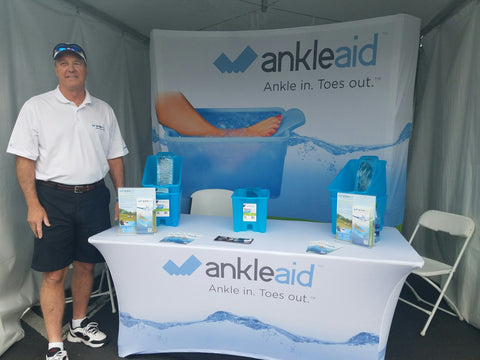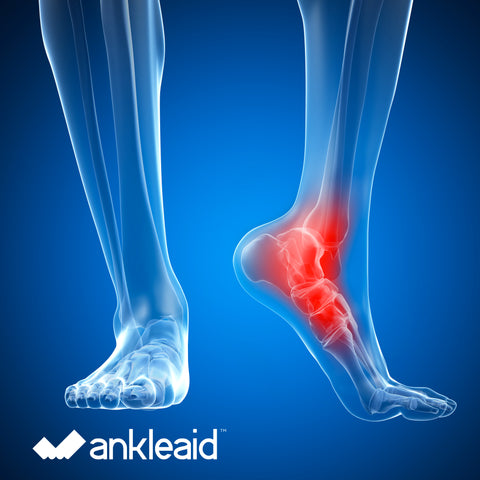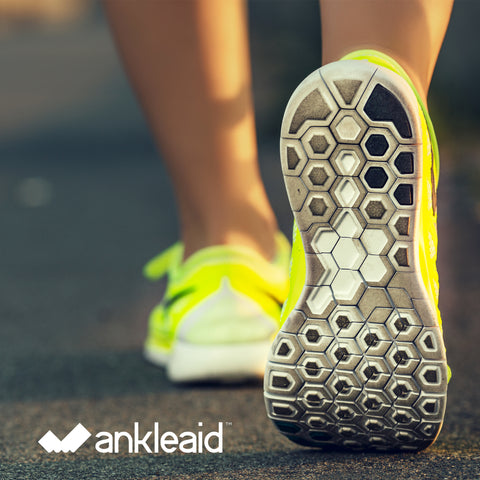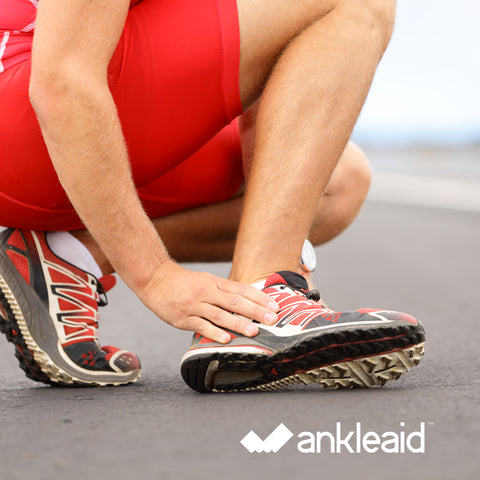The Ankleaid is the perfect ice bath for universities to have in their athletic departments to treat ankles. And, if you have several of them on-hand, you can treat multiple athletes at the same time. Plus it's portable so the athlete can take it home for treatment, which is critical to ice multiple times throughout the first 72 hours of an acute injury.
Here's what John J. Kasic MS ATC Cped, Associate AD/Sports Medicine at the University of South Carolina/Gamecocks Sports Medicine Department, has to say:
"I wanted to drop you a note to let you know how much our athletes and staff appreciate the Ankleaid. It works beautifully in getting the ankle and foot area iced while keeping the toes out of the frigid temperatures! We also use it for elbows pretty effectively. Every athletic training room has a few and they get used every day. Thank you again for bringing this tool to our attention. We’ll be ordering more soon."

AnkleAid founder, Scott McKay, is a lifetime athlete who has nearly mastered the game of golf. His passion for the sport runs deep, which is one of the reasons he invented AnkleAid. Over the years, Scott has suffered from countless ankle injuries. When his toes just couldn't withstand the traditional ice bath, he looked for alternatives. And when nothing else could satisfy him, he decided to create a new product, AnkleAid. You can read more about Scott and his story here.
Since AnkleAid launched, the golfing community has embraced the product. In fact, AnkleAid is sold at 8 Golf Courses on the East Coast. As part of AnkleAid's commitment to the golfing community, the company sponsored Walgreen's Charity Golf Classic "The Legends Tour." We were one of many sponsors, including Coca-Cola, Pepsico, Hersey, Dr. Pepper/Snapple, among others (see sponsor graphic below).


Ron Mirek, National Sales Director for AnkleAid is pictured above with the AnkleAid booth at Walgreens Charity Golf Classic "The Legends Tour."
The Legends Tour showcases the talents of LPGA Tour professionals age 45 and over and represents some of the most memorable and talented female golfers in the history of the game. With 120+ members and growing, The Legends Tour roster of players has combined for nearly 750 wins on the LPGA Tour, including 80+ major championships. Fourteen LPGA and World Golf Hall of Famers play The Legends Tour; nine have served has Solheim Cup captains and dozens more have played Solheim. The tour has helped raise over $18 million for charity.
We are very proud to have been a part of this tremendous event!
John Robert Isner is an American professional tennis player, currently ranked #19 in singles. He's originally from Greensboro, NC but currently resides in Tampa, FL. He began playing tennis at age 9. While attending the University of Georgia, he set school records for singles and doubles wins as a 4-year All-American.
John is 6'10" tall. He plays Right-handed with a two-handed backhand. He prefers hard court to clay. His Coaches are Rene Moller and David MacPherson. His Fitness Trainer is Kyle Morgan and his Chiropractor is Clint Cordial.
Here is John using AnkleAid in post training therapy:


Tissue treated in cold-water immersion remains cooler significantly longer which translated means a better therapeutic treatment. However, patients tend to have an aversion to full foot immersion because of the cold discomfort to the toes (personal clinical experiences). The most common method of reducing the toes discomfort is to apply a ‘toe cover’, which reduces the amount of cold water reaching the toes, but many patients still prefer ice bags. The AnkleAid is a single foot cold-water immersion device, which features a preformed area for placing the injured foot, which ensures a 360 degree cold-water immersion and keeps the toes out of the water for patient comfort. The application of cryotherapy ranges from acute injury (e.g. ankle sprains), gout, malleolar fractures, rheumatoid arthritis, plantar fasciitis, achilles tendonitis post surgical and post rehabilitation therapy.
This post was contributed by Professor Lennart Johns at Quinnipiac University.

A recent report by Rupp, etal. (2012) compared the cryogentic effects of crushed ice bag versus cold water immersion. The results demonstrate that both methods work equally well in decreasing tissue temperature and there was no statistical difference in the amount of time required to cause a decrease of 8 degrees Celsius. The significance of this study lies in the time required for the tissue to return to normal temperature. Specifically, the tissue that was cooled via cold-water immersion remained cooler significantly longer, which translated clinically, suggests that cold-water immersion would decrease the amount of secondary cell injury as compared to ice pack applications. The longer rewarming time is likely due to cooling the tissue 360 degrees around the entire limb as compared to the ice bag application, which cools unidirectional (Rupp etal, 2012). This entire limb cooling becomes important especially in the acute ankle injuries; because many moderate to severe lateral ankle sprains result in soft tissue on the medial side of the ankle.
This post was contributed by Professor Lennart Johns at Quinnipiac University.

The use of cryotherapy is considered the standard of care for acute injury across the medical field. The primary physiological goals when using cryotherapy is to decrease tissue temperature, which in turn decreases cellular metabolism, the utilization of anaerobically produced ATP, lactic acid concentrations and secondary cell injury. Clinically, the decrease in secondary cell injury translates to a decrease in the extent of the injury and a quicker recovery, return to daily activities and work. The application of cryotherapy ranges from acute injury (eg. ankle sprains), gout, malleolar fractures, rheumatoid arthritis, plantar fasciitis, achilles tendonitis post surgical and post rehabilitation therapy.
This post was contributed by Professor Lennart Johns at Quinnipiac University.

"I have suffered with plantar fasciitis for as long as I can remember. I’ve had cortisone shots, I wear orthotics, and I stretch regularly. Yet, I still suffer with soreness in my arch and on my heel. Flare-ups range from minor to major, depending on how much activity I engage in that day.
For the days when it's really hurting, deep tissue massages coupled with ice therapy are the doctor's orders. But let's face it - ice therapy is torture. Many doctors tell you to dunk your entire foot into an ice bucket, which according to them is the best method to get the full tissue treatment. This is so unbelievably painful because my toes are so sensitive that they almost immediately freeze and I can’t take the pain associated with that. I discovered a product called AnkleAid. This is a neat product that allows you to soak my ankle in ice-cold water with my toes out, which is great because they are so ultra-sensitive. A 10-minute soak in the AnkleAid is all it takes to gain relief from the pain.”
Note: AnkleAid can also be used with hot water as well.

For physicians, physical therapists, and athletic trainers, this is a summary of a study/article "The effect of cryotherapy on nerve conduction velocity, pain threshold and pain tolerance," published by Amin A. Algaflly and Keith P. George in the British Journal of Sports Medicine,which supports AnkleAid's recommended 54 - 60 degree water temperature, as this study suggests skin temp of 10-15 C (50-59F), 26 min treatment with crushed ice is optimal.
Objectives: To determine the impact of the application of cryotherapy on nerve conduction velocity (NCV), pain threshold (PTH) and pain tolerance (PTO).
Design: A within-subject experimental design; treatment ankle (cryotherapy) and control ankle (no cryotherapy). Setting: Hospital-based physiotherapy laboratory.
Participants: A convenience sample of adult male sports players (n = 23).
Main outcome measures: NCV of the tibial nerve via electromyogram as well as PTH and PTO via pressure algometer. All outcome measures were assessed at two sites served by the tibial nerve: one receiving cryotherapy and one not receiving cryotherapy.
Results: In the control ankle, NCV, PTH and PTO did not alter when reassessed. In the ankle receiving cryotherapy, NCV was significantly and progressively reduced as ankle skin temperature was reduced to 10˚C by a cumulative total of 32.8% (p,0.05). Cryotherapy led to an increased PTH and PTO at both assessment sites (p,0.05). The changes in PTH (89% and 71%) and PTO (76% and 56%) were not different between the iced and non-iced sites.
Conclusions: The data suggest that cryotherapy can increase PTH and PTO at the ankle and this was associated with a significant decrease in NCV. Reduced NCV at the ankle may be a mechanism by which cryotherapy achieves its clinical goals.
Go to the Full Article/Study.

AnkleAid can be used by athletes for recovery from fitness injuries and is an affordable way to treat sprained ankles, plantar fasciitis, Achilles injuries and a host of other foot/ankle issues. For people with chronic pain, AnkleAid can be used to help alleviate this through ice and heat therapy, and help you lead a more fulfilling and relatively pain free life. The AnkleAid is able to provide both cold and hot therapy, so it’s an all-in-one solution for certain foot and ankle issues.

Plantar Fasciitis is not a well-known foot ailment. Plantar Fasciitis is the Latin name for the more commonly known ailment, Jogger’s or Policeman’s heel. Although not very well known, it is very common and thought to affect a large portion of the population. Common causes are; standing for long periods, obesity and over exercise. While not a serious medical condition the shooting pain it causes in the bottom of the foot and heel can be excruciating. Fortunately, it can usually be treated at home with contrast therapy achieved with two AnkleAid’s. Contrast therapy is highly recommended by many doctors and includes alternating between a cold and hot foot bath.

Plantar fasciitis is a common cause of heel pain. It is pain and inflammation of thick tissue, called the plantar fascia. The fascia spans the bottom of the foot and connects your toes to your heel bone.
The pain most often occurs first thing in the morning after getting out of bed and includes stabbing pain that normally lessens after normal daily activity. It is most common in runners or overweight people. Pain relievers, physical therapy, night splints or orthotics may help improve plantar fasciitis.
Contrast therapy is highly recommended by doctors to offer relief to plantar fasciitis patients. This therapy includes alternating hot and cold baths. The best product to achieve this therapy in an efficient and cost effective way is the AnkleAid. The product is inexpensive and the perfect size to be able to utilize two AnkleAid’s in a small space.

From the minute you wake up and take that first step out of bed through the rest of the day, plantar fasciitis is painful. Rest is one solution, but that’s often impractical for most people. Orthotics can be very costly but can help offer some relief. In conjunction with orthotics, AnkleAid is an inexpensive, and easy-to-use solution for plantar fasciitis recovery, and for other ankle injuries, too. AnkleAid’s proven cold treatment therapy reduces blood flow to decrease inflammation and ease tissue damage. It is used by elite athletes and recommended by many Podiatrists, Physical Therapists, and Athletic Trainers.

Plantar fasciitis is thickening of the plantar fascia, a band of tissue running underneath the sole of the foot.

Normally the majority of people who suffer from Plantar fasciitis are:
- Overweight
- Runners (especially distance runners)
- On their feet for several hours each day
- Have medical conditions such as rheumatoid arthritis or lupus
Plantar fasciitis can be treated many ways. Rest is critical. If possible, stop daily activities that are causing your heel pain. Wear shoes with good cushion and the right arch support for your foot such as running shoes.
A great way to treat plantar fasciitis is to use contrast therapy also known as "hot/cold immersion therapy." One of the easiest ways to treat yourself with contrast therapy is by using 2 AnkleAids.
- Start by immersing your foot for 3 minutes in the hot water filled AnkleAid.
- Then immerse in the cold water filled AnkleAid for 1 minute.
- Repeat these steps 4 to 5 times.
The AnkleAid is designed to allow your feet to sit comfortably with a slight stretch, making sure that you get the best treatment possible. AnkleAid can be also be used to treat sprained and broken ankles, Achilles injuries, and even elbow injuries.
Visit our Contrast Therapy page for more information.
The following press alert was recently released by Quinnipiac University.
-------------------------------------------------------
Quinnipiac University students help give traction to AnkleAid
Hamden, Conn. – Jan. 7, 2014 – Quinnipiac University athletic training students have helped give traction to AnkleAid, a patented hard plastic foot bath designed to revolutionize the way athletes at all levels rehabilitate their sprained ankles, torn ligaments and injured Achilles tendons.
AnkleAid is designed to surround the injured area with hot or cold water treatment and keep the toes out, with the foot at the optimal angle for maximum comfort and a slight stretch to promote dorsiflexion which is critical in the treatment of most lower extremity injuries.
Scott McKay, founder and CEO of AnkleAid, recently donated 64 devices to Quinnipiac’s Department of Athletic Training and Sports Medicine in July. They are used in classrooms, at clinical sites and by the university’s athletic department.
Lennart Johns, professor and chair of athletic training and sports medicine, said Quinnipiac students have used AnkleAid at local high schools and introduced the therapeutic device through a Quinnipiac program that matches aspiring athletic trainers with some of the top college football programs in the country. The list includes Stanford, Holy Cross, Bucknell, Lafayette, Wyoming, Rutgers, Colorado and Maryland.
Johns said, “We’ve heard nothing but positive feedback” about the AnkleAids, which are portable, stackable and less painful than traditional footbaths.
“The athletes like the concept of not having their toes hurt as much,” Johns said. “They can use it while watching film or during chalk talks. The athletic trainers like the convenience of the device. We see sprained ankles all the time. Unfortunately, they keep athletic trainers in business.”
McKay has discovered that a variety of people are using the AnkleAid for all sorts of injuries and ailments from plantar fasciitis to elbow damage.
Interest in AnkleAid continues to grow and it is now in use in 27 states in homes, high schools, physical therapy centers, orthopedic and podiatric physician offices and college and professional sports teams training facilities.
McKay said he started developing AnkleAid five years ago out of frustration with the pain associated with frozen toes. The Connecticut native “played every sport imaginable” growing up and suffered torn ligaments during a pick-up basketball game in college.
“That was the start on the road to multiple ankle injuries and a lot of icing,” he said. “One day, I couldn’t take it anymore.” His athletic trainers over the years always promoted full foot immersion in an ice bath as recommended treatment
There had to be a better way, McKay thought, so he fashioned his first AnkleAid with the help of an oblong champagne bucket, a butchered Nike sneaker and some hooks from the garage.
“It worked awesome,” McKay said. “It kept your toes out of the water and your ankle in. It’s portable, easy to use and promotes greater therapeutic compliance because it’s significantly less painful than full immersion.”
McKay began searching for manufacturers in 2012, ultimately finding a U.S. company to make the product. After numerous prototypes, he began selling AnkleAids in 2014.
While Quinnipiac students have benefited from AnkleAid and helped spread the word about its usefulness, McKay’s Ellington-based company also has support from alumni Brady Giroux and Bob Moore.
Giroux, a School of Business graduate and former member of the golf team, is a part owner, while Moore, a 1983 graduate and CEO and founder of Moore Physical Therapy in Fairfield County.
Giroux’s late father, Hunter, CEO of Connecticut Occupational Medicine Partners, LLC., was a proponent of AnkleAid. Brady Giroux became involved after his death.
“It’s a great product and there is a market for it,” he said. “People have been using peas, ice packs and full immersion ice baths. AnkleAid is a wonderful product and it is starting to get a lot of momentum.”
Moore said McKay’s device is ergonomically correct, provides a comfortable stretch and is easy to use.
“It just makes sense,” he added.
McKay said he will market the product at tradeshows and marathons across the U.S. in 2015. AnkleAid is available at AnkleAid.com, Amazon, Ebay, Collins Sports Medicine, Sports Health, Alimed, Schein and other medical equipment distributors.
“Retail is our ultimate goal,” he said. “The CVS’s and Walgreens of the world will all have this. AnkleAid should be in every home, kind of like ace bandages and Band-Aids.
Quinnipiac is a private, coeducational, nonsectarian institution located 90 minutes north of New York City and two hours from Boston. The university enrolls 6,500 full-time undergraduate and 2,500 graduate students in 58 undergraduate and more than 20 graduate programs of study in its School of Business and Engineering, School of Communications, School of Education, School of Health Sciences, School of Law, Frank H. Netter MD School of Medicine, School of Nursing and College of Arts and Sciences. Quinnipiac consistently ranks among the top regional universities in the North in U.S. News & World Report’s America’s “Best Colleges” issue. The 2015 issue of U.S. News & World Report’s America’s “Best Colleges” named Quinnipiac as the top up-and-coming school with master’s programs in the Northern Region. Quinnipiac also is recognized in Princeton Review’s “The Best 379 Colleges.” The Chronicle of Higher Education has named Quinnipiac among the “Great Colleges to Work For.” For more information, please visit www.quinnipiac.edu. Connect with Quinnipiac on Facebook at www.facebook.com/quinnipiacuniversity and follow Quinnipiac on Twitter @QuinnipiacU.
###
Media Contact:
John W. Morgan, associate vice president for public relations, Quinnipiac University
(203) 582-5359 (office)
(203) 206-4449 (cell)
R.I.C.E. is one of the most frequently used and most effective treatments of soft-tissue injuries. It has proven especially successful in treating ankle, achilles-tendon, arch, and heel injuries and conditions. R.I.C.E. stands for “Rest, Ice, Compress, and Elevate,” which are the four pillars of this therapy approach.
-
Rest: This is an essential condition for a successful recovery of practically any injury, especially the injuries of ankle and other foot structures, which is due to their heavy workload.
-
Ice: This is one of the most important aspects of the R.I.C.E. treatment, especially during the initial 72 hours after the injury. Ice treatment significantly reduces swelling and other symptoms and increases the recovery speed.
-
Compress: Compression of the affected area helps prevent swelling, thus reducing the symptoms and allowing a quicker recovery.
-
Elevate: This is a simple, yet efficient way to help reduce the swelling and facilitate drainage of toxic metabolites from the affected area.
The U.S. company, AnkleAid, has developed an effective and comfortable solution for the ice component of the R.I.C.E. treatment of ankle, Achilles, arch, and heel injuries and conditions. It is a water-submersion device that enables the ankle and foot to immerse into the ice water, while assuming a comfortable, slightly stretched position. This slightly stretched position promotes dorsiflexion which is also critical to treating injuries. As mentioned above, ice treatment is one of the critical components of the R.I.C.E. therapy approach, especially during the first 72 hours following the injury. That is why AnkleAid is very valuable for the treatment of ankle and other foot injuries. In addition, the AnkleAid submersion device allows you to keep the toes above the water surface, which makes the treatment much more comfortable and easier to endure. Visit AnkleAid.com to learn more about this interesting product.
At the team practice on October 11, Oklahoma City Thunder star Kevin Durant sustained an injury in his right foot that will keep him off the court for 6-8 weeks. Durant suffered a Jones fracture, which is a fracture of the fifth metatarsal bone. After successful surgery, which was performed on October 16, he began a recovery, and will be re-evaluated in 4-5 weeks. Jones fracture is not uncommon in the NBA, so from previous experience, and according to the Thunder officials, Kevin Durant is expected to miss 6-8 weeks of the new season.






















